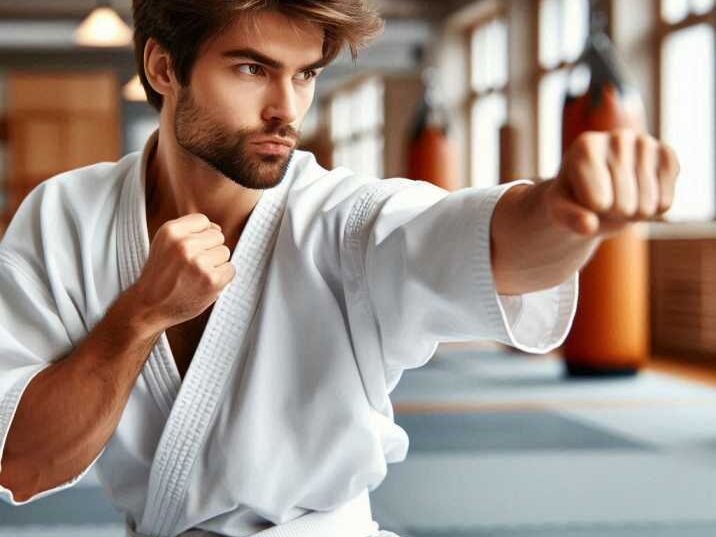Introduction
Table of Contents
Karate is a martial art that requires focus, dedication, and years of consistent practice to master. Many people wonder how long it takes to become a karate expert or earn a highly respected black belt. The answer isn’t simple because it depends on several factors like the time invested in training, the style of karate, and the individual’s learning pace.
In this article, we will explore the journey of learning karate, how many years it typically takes to complete it, and the benefits it offers, such as improved focus and discipline, and we’ll break down everything in a way that’s easy to understand, even for grade 5 students!

What Does It Mean to Complete Karate?
Completing karate generally refers to achieving the black belt, which symbolizes a high level of skill and knowledge in this martial art. However, even after reaching the black belt level, many karatekas (karate practitioners) continue to learn and perfect their skills throughout their lives.
Different Belt Levels in Karate
Karate uses a belt system to indicate the level of a student. These are often referred to as Kyu (student ranks) and Dan (black belt ranks). The progression through the belts typically follows this order:
- White Belt – Beginner level
- Yellow Belt
- Orange Belt
- Green Belt
- Blue Belt
- Brown Belt
- Black Belt – Mastery level
How Many Years Does It Take to Reach a Black Belt in Karate?
It can take anywhere from 3 to five years of continuous training to achieve a Black belt in Karate. However, the time frame is dependent on the frequency students train as well as their commitment to the specific requirements of their school of karate.
Factors That Affect the Time to Complete Karate:
1. Training Frequency
The more frequently you train, the faster you’ll be able to advance in the art of karate. Students who take Karate classes many times per week are more likely to boost more quickly than those who train only once or twice. Regular repetition of the techniques assists in building muscle memory and improves the mind-body connection vital to karate training. For example, practicing every week for 4-5 hours can help you master abilities quicker, whereas less frequent training can hinder your progression to the next belt level.
2. Karate Style
Karate training has several different styles, and each one has its belt advancement requirements and curriculum. Some of the popular styles include:
- Shotokan: Known for its powerful linear techniques, Shotokan karate may require a longer training period before advancing to higher belts due to its emphasis on precise form.
- Goju-Ryu: This style focuses on hard and soft techniques, requiring students to master different movements that may take time to perfect.
- Kyokushin: A more physically demanding style, Kyokushin involves full-contact sparring, which may require students to build endurance before advancing.
Because of these unique requirements, the time it takes to move through the ranks can vary significantly between styles. For example, in one style, it might take two years to move from a green belt to a brown belt, while in another style, it could take three or more years for the same advancement.
3. Age and Physical Fitness
Your age and physical fitness also play an important role in how quickly you progress in karate training. Younger students tend to be more flexible and have higher energy levels, which can help them learn techniques faster and recover quickly from physical exertion. However, age isn’t always a limiting factor—many adults start learning karate later in life and progress steadily by staying committed to their training.
Physical fitness is another factor to consider as Karate training is an extremely physically demanding art of martial arts. Students with good endurance, strength, and flexibility are more likely to be more effective in their training and will progress in the belts faster. However, students who are just beginning to build up their fitness may require extra time to develop the physical strength required to perform Karate moves correctly
4. Instructor Requirements
Each dojo or karate instructor (karate school) is required to meet certain guidelines for the advancement of belts. Certain instructors might insist on mastery of technique over the speed of progress, which means that students need to demonstrate the highest level of proficiency and know-how before they move on to the next belt. This method may reduce the time required to master karate, but it assures that students are adequately prepared at every stage.
Contrarily, some instructors might allow students to rise to the ranks faster when they’re committed and have shown improvements. But this doesn’t mean instructors’ quality is diminished. Even in the dojos with a faster pace, students are still required to meet the strictest physical and mental standards.
The tests for belts themselves may be challenging and vary in difficulty. Some instructors use more rigorous examinations, where students are required to demonstrate proficiency in a range of different techniques like forms, kata (forms), and Kumite (sparring) before advancing. In some cases, there are also waiting periods between tests, where students must show continued practice and improvement before they are eligible to test for the next belt.
Why Does Karate Take So Long to Master?
Karate training is about more than just physical movements; it’s also about developing a strong mind, learning discipline, and building confidence. Students spend years mastering the correct techniques and internalizing the philosophies that guide karate practice. Learning karate requires practicing kata (forms), kumite (sparring), and mastering the mental discipline necessary for improvement.
Learning at Your Own Pace
It’s important to remember that everyone learns at their speed. Some students may take longer to achieve a black belt because they focus more on perfecting their technique rather than advancing quickly through the ranks.
Benefits of Karate for Kids
Karate is especially beneficial for children because it teaches self-discipline and can lead to improved focus in school and other activities. Here are a few benefits:
- 1. Improved Focus
Karate training teaches children to stay focused during training, which translates into better attention and concentration in other areas of life, especially school. When kids learn karate techniques, they need to pay close attention to their movements, breathing, and the instructions from their teacher. This level of concentration helps children develop the ability to focus for longer periods, whether it’s on a math problem or a reading assignment. As a result, children who practice karate often show improved academic performance because they can stay focused on their studies without getting easily distracted.
2. Discipline
Karate is built on the foundation of discipline and respect. Children learn the importance of following rules, listening to their instructor, and practicing regularly. They must attend classes consistently, follow a routine, and complete tasks step-by-step. This sense of discipline helps children understand the value of hard work and patience. As they move through the belt system, kids learn that reaching goals takes time, effort, and determination. The discipline they gain in karate can extend to other areas of their lives, such as completing homework on time, keeping their rooms tidy, and being respectful to parents and teachers.
3. Physical Fitness
Karate is a great way to keep kids physically fit while having fun. The training involves a lot of physical activity, such as punching, kicking, sparring, and performing forms called kata. These exercises help build strength, improve flexibility, and increase endurance. Over time, children become stronger and more agile, which benefits their overall health. Karate also encourages kids to stay active instead of spending too much time in front of screens. By regularly participating in this martial art, children can develop lifelong habits of physical fitness, reducing the risk of obesity and other health issues.
4. Self-Confidence
One of the biggest benefits of karate for kids is the boost in self-confidence. As they learn new techniques, overcome challenges, and advance through the different belt levels, children feel a sense of accomplishment. Each new belt represents hard work and progress, which builds their confidence in their abilities. This self-confidence isn’t just limited to karate; it extends to other areas of their lives, such as school and social interactions. Knowing they can handle challenges, whether in the dojo or daily life, helps children feel more confident in themselves and their abilities.
Common Karate Training Techniques
Kata (Forms)
Kata training is a series of pre-arranged movements that teach students how to fight imaginary opponents. Learning kata improves coordination and helps students practice technique.
Kumite (Sparring)
Kumite is the practice of sparring with another student. It allows karatekas to test their skills in a controlled environment, improving offense and defense.
Basic Techniques (Kihon)
Kihon involves practicing basic punches, kicks, and blocks. These fundamental techniques are essential for progressing in karate.
How Karate Develops Concentration and Discipline
As students practice karate, they learn to focus on their movements and breathe in sync with their actions. The level of concentration can translate to better focus in school, homework, and even sports. Additionally, the discipline gained from karate training helps students follow instructions, stick to schedules, and set goals for themselves.
Karate Belt Progression Table
| Belt Color | Rank | Time to Achieve |
|---|---|---|
| White | Beginner | 3-6 months |
| Yellow | 9th Kyu | 6-12 months |
| Orange | 8th Kyu | 1-2 years |
| Green | 7th-6th Kyu | 2-3 years |
| Blue | 5th Kyu | 3-4 years |
| Brown | 3rd-1st Kyu | 4-5 years |
| Black | 1st Dan | 5+ years |
Conclusion
Completing karate takes time, effort, and dedication. While it may take an average of 3 to 5 years to earn a black belt, the journey is full of rewarding experiences that shape both the body and the mind. Students not only learn self-defense but also gain focus, discipline, and confidence that last a lifetime. No matter how long it takes, the skills learned in karate will benefit students throughout their lives.

FAQs
- How long does it take to get a black belt in karate?
It usually takes about 3 to 5 years to earn a black belt in karate, depending on the student’s dedication and practice frequency. - What is the highest belt in karate?
The black belt is the highest rank in karate, but even after achieving it, there are higher Dan levels for advanced practitioners. - Can you learn karate faster?
Practicing more often and showing dedication can help you advance through belts more quickly, but it’s important to focus on mastering techniques. - Is karate good for kids?
Yes! Karate helps kids develop focus, discipline, and self-confidence, while also keeping them physically active. - What is the first thing you learn in karate?
The first thing you learn is basic kihon (punches, kicks, and blocks) and the white belt kata, which teaches fundamental movements.


